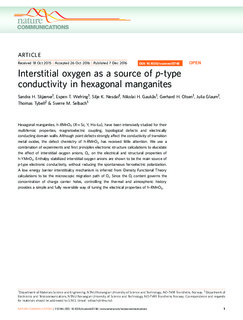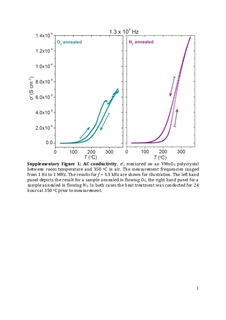| dc.contributor.author | Skjærvø, Sandra Helen | |
| dc.contributor.author | Tjønneland Wefring, Espen | |
| dc.contributor.author | Nesdal, Silje K. | |
| dc.contributor.author | Gaukås, Nikolai Helth | |
| dc.contributor.author | Olsen, Gerhard Henning | |
| dc.contributor.author | Glaum, Julia | |
| dc.contributor.author | Tybell, Per Thomas Martin | |
| dc.contributor.author | Selbach, Sverre Magnus | |
| dc.date.accessioned | 2017-11-22T08:00:43Z | |
| dc.date.available | 2017-11-22T08:00:43Z | |
| dc.date.created | 2017-01-03T11:53:48Z | |
| dc.date.issued | 2016 | |
| dc.identifier.citation | Nature Communications. 2016, 7 . | nb_NO |
| dc.identifier.issn | 2041-1723 | |
| dc.identifier.uri | http://hdl.handle.net/11250/2467453 | |
| dc.description.abstract | Hexagonal manganites, h-RMnO3 (R=Sc, Y, Ho–Lu), have been intensively studied for their multiferroic properties, magnetoelectric coupling, topological defects and electrically conducting domain walls. Although point defects strongly affect the conductivity of transition metal oxides, the defect chemistry of h-RMnO3 has received little attention. We use a combination of experiments and first principles electronic structure calculations to elucidate the effect of interstitial oxygen anions, Oi, on the electrical and structural properties of h-YMnO3. Enthalpy stabilized interstitial oxygen anions are shown to be the main source of p-type electronic conductivity, without reducing the spontaneous ferroelectric polarization. A low energy barrier interstitialcy mechanism is inferred from Density Functional Theory calculations to be the microscopic migration path of Oi. Since the Oi content governs the concentration of charge carrier holes, controlling the thermal and atmospheric history provides a simple and fully reversible way of tuning the electrical properties of h-RMnO3. | nb_NO |
| dc.language.iso | eng | nb_NO |
| dc.publisher | Nature Publishing Group | nb_NO |
| dc.rights | Navngivelse 4.0 Internasjonal | * |
| dc.rights.uri | http://creativecommons.org/licenses/by/4.0/deed.no | * |
| dc.title | Interstitial oxygen as a source of p-type conductivity in hexagonal manganites | nb_NO |
| dc.type | Journal article | nb_NO |
| dc.type | Peer reviewed | nb_NO |
| dc.description.version | publishedVersion | nb_NO |
| dc.source.pagenumber | 8 | nb_NO |
| dc.source.volume | 7 | nb_NO |
| dc.source.journal | Nature Communications | nb_NO |
| dc.identifier.doi | 10.1038/ncomms13745 | |
| dc.identifier.cristin | 1419827 | |
| dc.relation.project | Notur/NorStore: NN9264K | nb_NO |
| dc.description.localcode | This work is licensed under a Creative Commons Attribution 4.0 International License. The images or other third party material in this article are included in the article’s Creative Commons license, unless indicated otherwise in the credit line; if the material is not included under the Creative Commons license, users will need to obtain permission from the license holder to reproduce the material. To view a copy of this license, visit http://creativecommons.org/licenses/by/4.0/ | nb_NO |
| cristin.unitcode | 194,66,35,0 | |
| cristin.unitcode | 194,63,35,0 | |
| cristin.unitname | Institutt for materialteknologi | |
| cristin.unitname | Institutt for elektroniske systemer | |
| cristin.ispublished | true | |
| cristin.fulltext | original | |
| cristin.qualitycode | 2 | |


